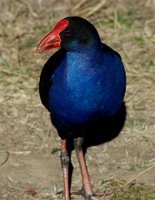 The other day, Zoe and I took my father out for a drive, and we ended up at the Lake (Lake Burley Griffin). There were a few, very hungry Swamp Hens (Purple Galinules)(Porphyrio porphyrio) around. Dad and I sat in the car, and watched these birds from close quarters, (birdwatching for the aged and the frail), while Zoe got out and took a few photos.
The other day, Zoe and I took my father out for a drive, and we ended up at the Lake (Lake Burley Griffin). There were a few, very hungry Swamp Hens (Purple Galinules)(Porphyrio porphyrio) around. Dad and I sat in the car, and watched these birds from close quarters, (birdwatching for the aged and the frail), while Zoe got out and took a few photos.
These birds are swamp-edge dwellers, normally, but they have had such a poor season that they have taken to digging up the nearly dry bulbous "crowns" of Kikuyu Grass, to eat. This is on the dry grassed areas surrounding the Lake. Slim pickings, indeed. Normally they pull up moist roots of swamp plants, reeds, etc.
"Swamp Hen Feeding"
 They are particularly well adapted to this manner of feeding, with their huge, powerful beaks (with a head-piece extension, which looks like a shield over the top of the head).
They are particularly well adapted to this manner of feeding, with their huge, powerful beaks (with a head-piece extension, which looks like a shield over the top of the head).
They hold the roots they are going to eat, under the foot, held there by the outer toe supporting the root, which is tucked up by the toes being slightly curled to hold it up along the "ankle" of the foot. My description is not good biology, but if you look a the picture, you will get the idea. The root is squeezed between the upper parts of the toes, not "grasped" in the way that a parrot grasps its food. Of course, their extremely long toes are designed primarily for spreading their weight over a large area, as they walk over water weeds, etc. So their feet are not suited to grasping, but are great for spanning a thin bunch of reeds, and floating water plants.
"Eurasian Coot"
 Zoe also had a chance to photograph the totally aquatic Eurasian Coot, (Fulica atra) which feeds by diving for water-weeds, which they bring to the surface, then eat, in small portions. On close examination of the photo at left (click for a larger image), you can see that the Coot has lobed toes, not a complete webbed foot (check the left foot), as a Duck has. But they are good swimmers and divers, none-the-less. Of course, their white beaks (with small head shields) are distinctive.
Zoe also had a chance to photograph the totally aquatic Eurasian Coot, (Fulica atra) which feeds by diving for water-weeds, which they bring to the surface, then eat, in small portions. On close examination of the photo at left (click for a larger image), you can see that the Coot has lobed toes, not a complete webbed foot (check the left foot), as a Duck has. But they are good swimmers and divers, none-the-less. Of course, their white beaks (with small head shields) are distinctive.

No comments:
Post a Comment